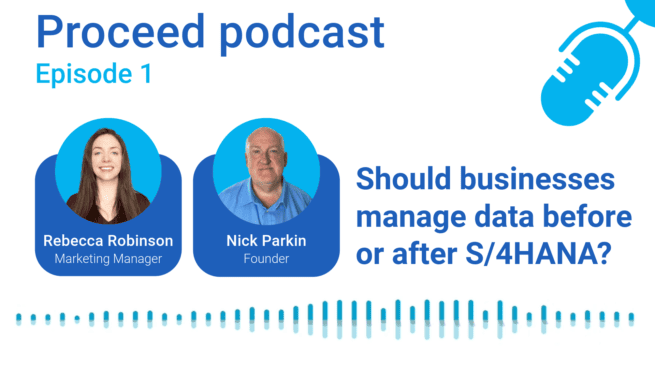
Should businesses manage data before or after S/4HANA?
In an episode of the Proceed podcast, we had the pleasure of sitting down with Proceed’s founder, Nick Parkin, to discuss the impact proper SAP data management can have on the S/4HANA journey’s success. You can enjoy the entire episode by watching the video above or review the key highlights below.
What do we mean by data management in the context of the S/4HANA journey?
Data management can mean different things to different people, but for Proceed, it boils down to a critical question: Do you really need all of this data in your SAP system? In the context of a migration, it’s essential to consider the age of your data. For example, if you are moving from an old ECC6 system with 20 years of data to S/4HANA, it’s worth asking if you truly need all 20 years of that data – or just seven to ten years. This decision should be based on your data retention needs, ensuring you only bring over the data that’s essential.
This is where Proceed comes in – our role revolves around deciding which data should reside in the S/4HANA system and what can be archived. Typically, only two years of data need to be in S/4HANA, while the remaining eight years can be stored in an archive for retrieval through S/4HANA transactions.
The impact of neglecting data management ahead of the migration
When planning a migration, two significant factors come into play:
Firstly, the size of the database you’re moving influences the cost, affecting both HANA memory expenses and, potentially, SAP licensing fees. A smaller database results in cost savings.
Secondly, the time required for the migration, especially in brownfield scenarios, is a critical consideration. Migrations need to be completed swiftly, as users go live on the system. The smaller the database – the quicker the migration will take place.
What are the consequences of not addressing data management before a transition to S/4HANA?
It’s essential to consider database size when migrating to S/4HANA. A large corporate customer with a 40-terabyte database reduced it to 30 terabytes but faced a 130-hour migration time—over five days of system downtime. To address this, they archived even deeper into their data to reduce the size of the database.
The cost implications of a migration
When a customer opts for on-premise HANA in their data center, it entails significant hardware investments. This includes the production system, a disaster recovery system of equivalent size, pre-production and quality assurance systems, a smaller development system, and a few sandboxes. For larger databases, this can amount to millions of pounds. However, data archiving can significantly reduce costs, potentially saving half of the initial investment. Numerous examples show that data management projects have led to monthly savings of tens of thousands of pounds, with significant returns on investment.
Additionally, the time required for Brownfield migrations can be reduced with a smaller database, resulting in considerable time and cost savings by minimising the need for multiple dry runs and data selection efforts.
By archiving data ahead of the migration to S/4HANA, businesses can cut hardware costs in half, saving millions for on-premise or hyperscaler deployments
Nick Parkin, Founder of Proceed Group
Advice to businesses embarking on their S/4HANA journey
To ensure a smooth data management project, it’s best to initiate it six to nine months before beginning the transition to S4. Running both concurrently can be challenging. The project requires a mix of IT, infrastructure, basis team, and functional personnel, and we have designed the process to minimise the business users’ time commitment. Business input is needed primarily for creating the archive strategy and during user acceptance testing, where the system is thoroughly checked for any issues. Over 700 projects have been successfully completed without disrupting the system, but rigorous testing remains essential for quality assurance.
What is the first step to getting started?
For businesses contemplating an S/4HANA transition, the first crucial step is recognising the data size issue. Often, companies underestimate the problem until it’s pointed out. Any database larger than two terabytes with more than three years of operation likely has a problem. Once identified, the next step is finding solutions. This might involve data archiving or deletion, but professional guidance is essential.
While some consider archiving as a mainly technical aspect, it only constitutes around 20% of the project. The remaining 80% involves working with business users to ensure satisfaction with archiving, data retrieval, internal and external audit access, and compliance requirements.
The key is to shrink down your database before making the transition to S/4HANA. Once you're on the new system, incorporate archiving from day one. Delaying this could result in a rapid, unwanted growth of your S/4HANA system within the first 6 months to a year.
Nick Parkin, Founder of Proceed Group
Further reading
[Case study] Croda International
[Blog] S/4HANA migration: Greenfield and brownfield best practices
[Service] More information on SAP data archiving
You may be interested in

Free SAP data archiving report
Proceed Group’s free SAP data archiving report analyses your ECC or S/4HANA data in minutes and pinpoints savings, performance boosts and compliance gaps before you migrate to RISE or the cloud.
Read more

SAP ECC archiving – Customer story
To keep SAP ECC and operations running smoothly, a global food business archived 14TB of legacy data and moved attachments to a content server. The result was a leaner 11TB database and a stronger foundation for future growth.
Read more

SAP decommissioning and its role in modern IT strategy
Stopping legacy SAP systems is easier said than done. This article shows why SAP decommissioning deserves a place in every transformation roadmap, what a successful project looks like and how to secure buy-in from finance, IT and compliance teams.
Read more

